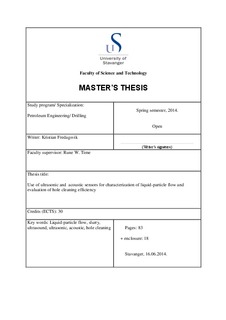| dc.description.abstract | The transportation of solids by suspension can cause severe damage to pipelines and infrastructures if not handled correctly. An adequate system for monitoring multiphase flow can be used to get early indications of erosion and poor hole cleaning. The use of ultrasonic and acoustic sensors has been reviewed for the application of slurry monitoring and evaluation of hole cleaning.
The theories of slurry flow in pipes are quite extensive and are mostly based on fluid mechanics. The various aspects of liquid-particle flow including flow patterns, pressure drop, particle transport and particles in suspensions have been studied. In order to characterize these flows, several non-intrusive methods such as ultrasonic, acoustic, sonar, nucleonic and electrical capacitance tomography (ECT) shows good accuracy. State-of-art systems in each category with accuracies are collected for comparison. The working principle of each system is described with sufficient theory. Various studies within acoustic and ultrasound, including detection of oversized material, velocity measurements and attenuation measurements, are useful for characterization of complex flows.
Wellbores are extended over longer distances with incline and horizontal sections to increase production and reduce the number of offshore platforms. To reach the pre-determined target in the reservoir, at a given depth and offset, hole cleaning must be considered. The outcome of poor hole cleaning in complex wells, will likely end up in sidetracking and abandoning, both costly operations. In the conventional vertical well, hole cleaning had no large impact compared to the more extensive wells. Hence the field of hole cleaning is now becoming more and more an important tool for hole improvement.
A method is presented in this master’s thesis, where hole cleaning efficiency is obtained by measuring drill-cuttings. The system utilize image analysis tool for Particle-Size Distribution (PSD), Cuttings morphology-tool for cuttings morphology, Roman Spectroscopy for cuttings mineralogy and Cuttings flow meter for total weight cuttings. The tool has been tested in the Cubility center in Sandnes and at rigsite. Some alternative methods such as Ultrasonic Flow Meter (USFM) for volume flow and Ultrasound Extinction (USE) to determine PSD are also discussed. | nb_NO |

